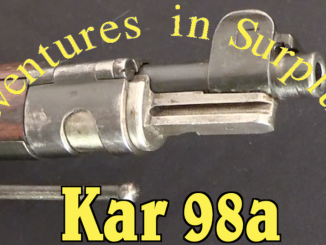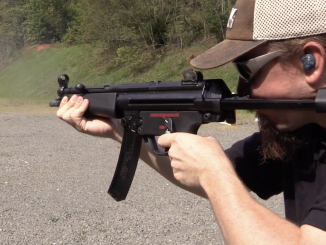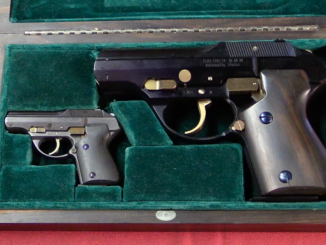During the late 1920 and early 1930s, the Walther company worked on developing a military pistol in 9x19mm. They began from the basis of the PP/PPK design, and produced three separate designs, the first two designed “MP” (Military Pistol) and the third being the Armee Pistole (which was followed by an improved model called, once again, the MP). The first MP was simply a blowback PP called up to 9x19mm, and it was not successful. The second model began to look more like the eventual P38 design, and that is what we are looking at today.
This MP has an exposed barrel like the P38, but the barrel is fixed to the frame like the PP. It uses a very unusual locking system, with elements of the Pedersen system as well as elements of a tilting bolt, short recoil design. It uses a recoil spring in the frame, but only one – probably lessons learned on the gun led to the P38’s dual springs. This design was also not successful, but the third one was, and eventually became the P38.
Only two of this pattern of Walther MP are known to exist – serial numbers 105 (this one) and 101.




First time I learn of this prototype. Thank you for the excellent, detailed demonstration/explanation of the locking mechanism and the firing pin safety. The trigger in double action mode must be quite hard due to its short travel.
A litte nitpicking: I am afraid the element you showed as actuating the firing pin safety is really the ejector. In the assembled pistol, the “pushbutton” in the slide is on the right. Therefore I think the much smaller bar projecting on the right side of the grip actuates the firing pin safety. The ejector is on the left side and in my view too far forward for that pupose.
Please note that the complicated magazine latch spring climbs up through the back of the grip and powers the hammer from its other end. I’ll bet there is a plug, strut, or connector up there, some kind of mechanical interface with the hammer. You will find this arrangement on the PP/PPKs (and a plethora of other hammer-fired semi-autos). This seems to be a crib from the Ruby pattern, which follows the same arrangement, but in some Rubys you’d be lucky to find a hammer strut, and the bottom end of the coil usually impinges directly on the magazine catch. I think the complication is not for its own sake, but to ensure durability.
A real treasure… Thanks Ian…
Sorry JPeelen… I am afraid that part is “Decocker Cam Lever” to be actuated by rotating safety… The “Ejector” seems as the little lug at top of left inside the magazine well…
The gun should be classified as “Delayed Blowback” since “Pedersen Hesitation Lock” does not hold the slide locked with barrel during the highest pressure existing in the barrel… It only functions as dissipating the recoil force during the very early stage of that happening… The breechblock seems moving to move freely recoiling at least three milimeters which clearly out of the distance needing of initial locking process.
However… Walther staffs seem tried to slow that free recoiling distance through a very strong spring which its function being also dubious under the inertial situation.
IMHO…
OK, Strongarm. But how do you explain that a lever protruding on the left side of the grip surface actuates a firing pin safety “pushbutton” located on the right hand side of the slide?
JPeelen,
You are right at identification of the location of “Firing Pin Safety Actuator”… It seems the little projection at the right side… It already moves via trigger actuation…
The thin pointed wing at the left side I mentioned, is the “Decocker Cam Lever”… The downwardy rolling safety lever at left side of the slide forces this lever down to free the single action sear out of hammer contact and the hammer falls over the solid, rolled surface of manual safety body… The construction is same with PP or PPK models…
“(…) “MP” (Military Pistol) and the third being the Armee Pistole (which was followed by an improved model called, once again, the MP)(…)”
Wait… so they first used English named Military Pistol then switched to Deutsch Armee Pistole? Why they did so? And also why elected to change to word of narrower meaning (Military does include also naval and aerial forces, Armee seems imply land forces, at least in Deutsch as used during WW2)?
I think they used the German “Militaer” for Military. Why they switched to the narrower “Army” I can only guess. For example, the redesign to an exposed barrel, a specification for allegedly shooting more easily out of armored vehicle ports, might indicate a marketing sales pitch to the armourers of mechanized infantry.
The exposed barrel requirement by the German Heer (engl: army) came from blocked barrels in the Great War. A P.08 for example is still able to fire with a bulged barrel, whereas barrels enclosed in the slide lock up the action, when bulged from firing wiht the bore obstructed with mud. Hence the later introduced P.38 having an exposed barrel. This obviously was not a hard requirement as lots and lots of closed slide pistols have also been issued in WW2. And there was less fighting on narrow muddy trenches.
Daweo, from my German view you are reading too much into commercial model names. As LDC remarked, MP obviously stands for Militärpistole (military pistol). Its a continuation from the commercial PP for Polizeipistole (police pistol). It looks like Fritz Walther wanted to abandon the numbering of models (8 and 9 had been the last).
For the final design he chose HP for Heerespistole (army pistol; in German Armee and Heer do have different meanings). This does not mean he did not want to sell it to Marine and Luftwaffe. A similar commercial “misnomer” would be the Colt Woodsman pistol.
Good point that i missed to mention, that these are names given by the manufacturer.
Another example of a commercial name would be the Smith & Wesson Military & police line. Both the Model 10 revolver that has been sold to civilians as well as governments. Just like todays offerings from S&W under the same M&P brand. I think the modern day pistols are mostly sold to private citizens and only few police forces have adopted them. And no military force that I am aware of. The Magpul/Bushmaster/Remington Advanced Combat Rifle is another example. Actually taking the name from the 1980ies Pentagon programme of the same name, but having nothing to do with it.
Carefully watching the video reveals that…
The gun does not work in “Pedersen Hesitating lock”… Since the breechblock does not begin functioning as unlocked situation… It starts with its back tilted down over the spring loaded stopping shoulder… Being ready to go upwards through recoil stroke under the resistance of a heavy leaf spring… In a situation to be said as if “ Semi locked”…
The gun should be classified in “Delayed Blowback” operation… IMHO…
Bit like the lock on a leatherman knife, but, delayed; so not a lock.
Bit “shit” really, like the g35; albeit they were learning about it at the time… And did not have such a fantastic resource as forgotten weapons, etc to learn about said stuff. Makes a big difference; knowledge.
I found this quite interesting. It suggests to me that a series of Thursday commentaries tracing out the development and evolution of the major design elements from originator to current products would be very interesting and something Ian is ideally suited to doing by virtue of interests.
Walther g35; who remembers that? “Screw lark” And it was, oh yes it was; and not in a good way. Anyway fair, play if you don’t try these things; with guns you’d never know.
Should try that more these days, the 200 + crap ones; don’t get released on the public for recall. Especially relevant for “Jumbo jets” given unwanted side effects… Such as 200+ dead. Or: https://youtu.be/PI_Jl5WFQkA Unexplained fires are a matter for the courts.
Thats another use for niti: https://en.m.wikipedia.org/wiki/RKG-3_anti-tank_grenade Type grenades… Top attack, they are dropping them from drones apparently. But another way is niti wire; have a reel you pull out calibrated to the length vs drop at so many yrds, the wire will pull the parachute in; thus dropping it on the roof. Probably better with a ww1 style grenade catapult for consistency of throw. No electric, fuse lark. matches the length you withdraw. Like a guy steering a parachute, just pulls it.
Ways.
Be everyones designed proxy war terminiators in a bit, thinking why don’t we just kill the warmongers shortley.
Want to think about these things, he he.
Be terminator “radar” jamming shit; beep, de beep like that… Against non robot drones, which doubtless will become robots.
Anyway, least it is a respite from Rona; my ear has improved.
No “signiture” from catapults, for terminators to register. Anyway I will shut up. Right though.
https://youtu.be/_Mg7qKstnPk
Incase anyone wasn’t born when said movie was out, he he!
Take this gun, could have been niti the resisting “Leatherman piece” would that not be a lock/delay?
“Be handy if someone who knows about niti could say yes and clarify it somewhat; only been asking for five years, he he.”
Clarify why though, he he… Not just no, cocknose.
https://youtu.be/GhHivzcQ7HI
British comedy program… Cocknose. 20 yrs ago that’ish; shocking.
In its hard state, like a big cock. Sort of… It’s the 100,000psi resistance thing I don’t get; I mean is it relative, so like an ant is so big but can lift a wee rock… We couldn’t if relative I.e. The rock. Or is it the amount if material, so like 1cm thick niti can push I don’t know 10cm thick of steel up which is heavier. Or none of the above?? Little help.
I mean I assume a 1mm thick wire of niti has a breaking point; say if it was resisted, what would the snapping resistence be?
I mean I assume a 1mm thick wire of niti has a breaking point; say if it was resisted, what would the snapping resistence be?
Quite; you know if said material had “blood” in it; heat in this case, something to change its state.
Say if I had a brocock air cartridge “Google it” but modified it, so I had some niti wire inside; heated it from the outside (Somehow) Ok… Right so the niti wire was folded, heat makes it want to stand up got straight… Now above it is a piston, and infront of that is air… And infront of that is a valve. So will the unfolding of the niti push the piston to squish the air and so open the valve?
Tut. I am learning Welsh you have had at least 5 years to read up on this for me.
Ydy hi’n prynu pannas?
Duolingo thing. Nac ydy.
Owen… Meh, anyway it works to read stuff; did a T.V licence in it, could read a fair amount in 6 months. Quite good. Did make me think about nationalism you know; I mean really Welsh is actually British “Ancient” lost lands = England lloegyr, so I do wonder really why instead of trying to be insular I.e. Nationalist, why they don’t actually say this is the most of the rest of you folks “lingo” anyway really. Do you know any Angles? And thus, gain a bigger nation like originally; King Arthur and whatnot. But meh.
Anyway what where we talking about, Lugers was it?
I say this in relation to a light gas gun; in-relation to a coil gun.
We could have a barrel of mini light gas guns, electrically operated; heat. All accelerating a slug; arrange it like a coil gun. All hydrogen, then it “recoils” refils, pumps out another round; caseless.
Gast gun arrangement; of guns to give constant fire.
A sort of “fart” atomic fart barrel… Far fetched, well you can bet your ass this is the kind of crap billion pound supercomputers will knock up for robots.
And not us. So think on, Ar’s bit useless.
Apart from theres work, he he! 🙂